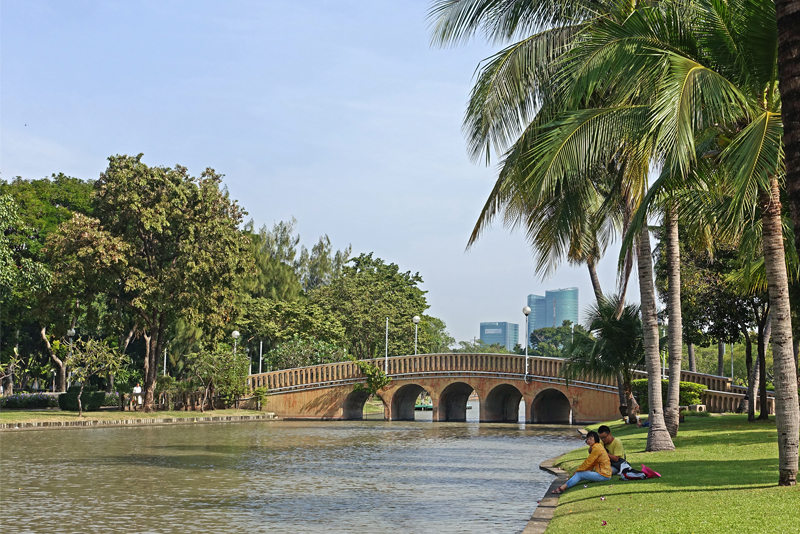How Bangkok stays green and blue


The Queen Sirikit Park is blessed with theme gardens, bridges and lakes for people to enjoy.
Last week I featured a trip to Hua Hin, a seaside resort destination south of Bangkok, which is not too popular with Filipinos but should not be overlooked as an option to the more crowded sites in Thailand.
We then headed back to the capital city of Bangkok. Most Filipino tourists are familiar with this bustling city and its wonderful river, the Chao Phraya. My wife Twink found us this great hotel on Soi Sukhumvit near the Thong Lo BTS station. She also chose the area because it had a concentration of good restaurants that rated well on Trip Advisor.
Bangkok is a foodie and shopping paradise for Pinoys. The requisite river and temple tours round out most planned tour itinerary. We grumble about the traffic, which has been compared to Manila’s but the city’s transit system is undeniably more tourist-friendly compared to our MRT/LRT mess. We got around our four-day stay relying mostly on Bangkok’s wonderful metro rail system. There were no long queues. The stations were clean and easily accessed, and most hotels (like our own) had shuttles to these stations.
While we hit the standard spots in Bangkok — like the palaces, temples and the Chatuchak Market — I convinced by wife and brood to also visit some of the city’s many parks. Unlike Manila, Bangkok has a system of large and small parks with five major ones in an around the city center.
I visited three: the Lumphini Park, the Benchasiri Park, and the Queen Sirikit Park beside the Chatuchak Market. My family accompanied me on the first jaunt but left me to ramble the remaining two, preferring the attractions of the markets and alleys; all better-maintained and cleaner for the most part compared to Manila’s equivalents — and relatively safer, too.
Early the second morning of our stay, we ventured early to the largest and most centrally located park, the Lumphini. It was only a few stations from Thong Lo and Google Maps did the rest. The Lumphini is a 57-hectare oasis in the middle of the city, about the size of the Rizal Park. It, however, has a close neighbor: the Benjakitti Park that adds another 21 hectares of usable and beautiful green space. City dwellers and tourists can do a five-kilometer run in a single loop that joins the two parks (they are connected by an elevated pedestrian way).
The two parks are well designed, well-maintained, and perceptively safe from a user’s point of view. One can safely take the whole family by public transport. Tourists feel safe as many take a run in the early morning and afternoons. Mid-day to late afternoon, the park roads are given to bikers. Bikes are available for rent in all parks and also for city use.
Lumphini has a large free-form lake, where you can go boating. Almost all parks in Bangkok have ponds and lakes, making Bangkok a green and blue city.
There are open-air fitness corners and several opportunities for snacks and beverages. Toilets are also clean and well-located. Surrounding the park on one side in the morning is a street filled with temporary noodle kiosks, but before mid-day they are dismantled and cleaners sweep and jet-wash the road for sanitary purposes. Where do we see this level of maintenance and sanitation in Metro Manila?
On our third day I tried out a smaller park halfway between the Benjakittii and Thong Lo station. The Benchasiri Park is a green space with a small lake as a focal point. It is right in the middle of a concentration of hotels and shopping malls and provides relief from a busy thoroughfare. It is roughly akin to Greenbelt Park in Makati but twice as big and publicly maintained.
Finally, on our last day we headed for the famous Chatuchak Market. For many Filipino tourists this is the highlight of any Bangkok visit. What most people do not notice is the large Queen Sirikit Park just next to the market. The park is a 22-hectare area and was designed as a botanical garden with 2,000 varieties of endemic and exotic species. It was competed in 1992 and named after the Thai queen. The park incorporates themed gardens, a series of ponds, playgrounds and settings for public art.
All throughout our trips across Bangkok we noticed much more open green and public parks and spaces compared to Manila. Bangkok has over 30 parks, all of them publicly maintained. Moreover, they are real parks, not spaces paved with sprawling concrete of filled with “multi-purpose” courts or buildings.
To me, Bangkok rivals Singapore as a green city. Sure, there is more traffic in the Thai city but its parks mitigate them and are relatively evenly distributed across the metropolis.
In Metro Manila, you only have two comparative open public park spaces to service the 12 million citizens of the metropolis. We do have some open space left that is government owned, but authorities are more inclined to sell these to developers or build even more buildings on them instead of conserving needed public space and greenery. Clearly we need to create a greener, cleaner and more equitable metropolis than that we have today.
* * *
Feedback is welcome. Please email the writer at mailto:paulo.alcazaren@gmail.com.



















